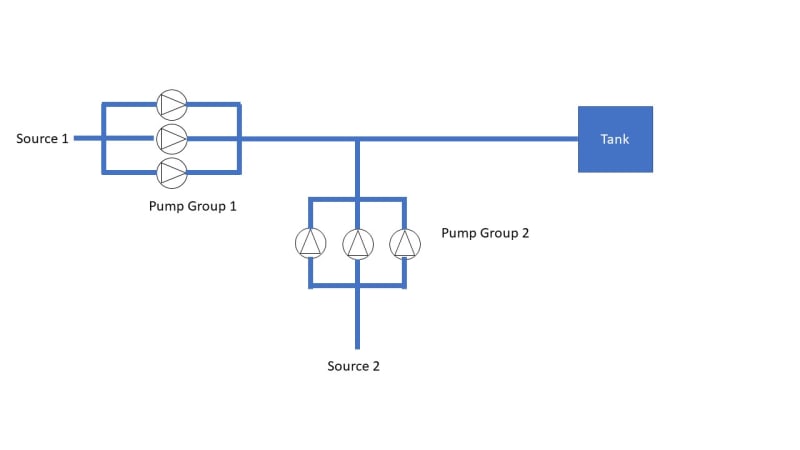Dear all,
I have a situation here which has been bothering me for a while and I really hope someone can give me their expertise on it.
Background:
I have two pump groups (let's assume three pumps in parallel each), which deliver up to 1.5 m3/s maximum.
The amount delivered can vary between pump group 1 and pump group 2 (depending on the supply upstream).
In normal operation, however, both pump groups should deliver the maximum flow of 1.5 m3/s.
The main line to the tank is relatively long and pump group 2 does not lead far from pump group 1 into the main line (i.e. they merge somewhere at the beginning of the pipeline).
Below you can find a very simple and basic sketch of the set-up:

I have thought of 3 scenarios on how I could choose the pump / motor type & control configuration:
[ul]
[li]Scenario 1: Equip the pumps in pump group 1 and 2 with VFD motors. Both flow controlled.[/li]
[li]Scenario 2: One pump group with fixed speed motors and downstream a pressure control valve. The other pump group with flow controlled VFD motors.[/li]
[li]Scenario 3: Both pump groups with fixed speed motors and a one with a downstream pressure control valve and one with a downstream flow control valve?[/ul]
My questions
If both pump groups are equipped with VFD motors: Does one pump group have to be pressure controlled with the other pump group being flow controlled?
Do you see a disadvantage to having one pump group pressure controlled? Is it possible that the flow set point cannot be maintained? Assuming that all pumps in the two groups have similar characteristics?[/li]
What would make the most sense in your opinion, smartes control configuration, or be technically easy to implement. For what reason?
I'm thanking all of you in advance for your valuable inputs.
Kindest regards,
Jack
I have a situation here which has been bothering me for a while and I really hope someone can give me their expertise on it.
Background:
I have two pump groups (let's assume three pumps in parallel each), which deliver up to 1.5 m3/s maximum.
The amount delivered can vary between pump group 1 and pump group 2 (depending on the supply upstream).
In normal operation, however, both pump groups should deliver the maximum flow of 1.5 m3/s.
The main line to the tank is relatively long and pump group 2 does not lead far from pump group 1 into the main line (i.e. they merge somewhere at the beginning of the pipeline).
Below you can find a very simple and basic sketch of the set-up:

I have thought of 3 scenarios on how I could choose the pump / motor type & control configuration:
[ul]
[li]Scenario 1: Equip the pumps in pump group 1 and 2 with VFD motors. Both flow controlled.[/li]
[li]Scenario 2: One pump group with fixed speed motors and downstream a pressure control valve. The other pump group with flow controlled VFD motors.[/li]
[li]Scenario 3: Both pump groups with fixed speed motors and a one with a downstream pressure control valve and one with a downstream flow control valve?[/ul]
My questions
If both pump groups are equipped with VFD motors: Does one pump group have to be pressure controlled with the other pump group being flow controlled?
Do you see a disadvantage to having one pump group pressure controlled? Is it possible that the flow set point cannot be maintained? Assuming that all pumps in the two groups have similar characteristics?[/li]
What would make the most sense in your opinion, smartes control configuration, or be technically easy to implement. For what reason?
I'm thanking all of you in advance for your valuable inputs.
Kindest regards,
Jack

![[hairpull2] [hairpull2] [hairpull2]](/data/assets/smilies/hairpull2.gif)